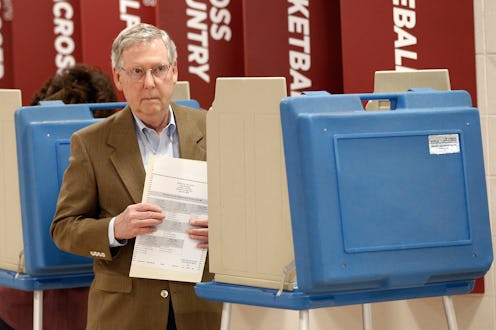The Bluegrass state's Democratic primary was one of the closest yet with voter turnout proving to be steady, but not shocking. Overall, about 20 percent of Kentucky's voting population participated in the state's 2016 primary elections. The turnout, which was calculated by dividing the sum of the Republican and Democratic votes by the state's 3.2 million registered voters, proved Kentucky Secretary of State Alison Lundergan Grimes' earlier estimations correct. The week prior to the Democratic primary, Lundergan Grimes expected turnout to be fairly low because the Republicans and Democrats held their elections on separate days.
While presidential primaries generally draw significant interest, overall turnout will likely to be driven lower because Republicans held a presidential caucus earlier this year.
When broken down into Democratic and Republican voter turnout, however, the numbers look much different. Because the state has a closed primary, Tuesday's ballots were only open to registered Democrats. The actual voter turnout among only Democrats on Tuesday was about 25 percent — a much more impressive number. This proportion was obtained by dividing the number of Democratic votes by the number of voters registered under the Democratic Party, according to the State Board of Elections. On the other hand, only about 17 percent of registered Republicans cast their vote during the March 5 caucus. This number was obtained using the same method.
The state's 2016 primary voting pattern fell somewhere in between that of 2012 and 2008. In 2012, the Lexington Herald Leader reported, only 13 percent of Kentucky's registered voters cast their ballots. In 2008, voter turnout during the primaries spiked to 31 percent, most likely due to the fact that George W. Bush had already served two terms and could not run for re-election. For the first time since then, America is witnessing the same scenario, but Kentucky's voter turnout didn't match up.
For the Republicans, the especially low turnout was likely due to the fact that Kentucky had switched from a primary system to a caucus in 2016. Caucuses require more time and mandate that each voter publicly display his or her political allegiance, which could have deterred some voters from dedicating themselves to the process. For Democrats, the gap in turnout compared to 2008 can be partially attributed to the assumption that Bernie Sanders' lost out on the Independent vote because of the state's closed primary. In Kentucky's case, for example, Independent voters would have had to register with the Democratic Party at least 29 days prior to the primary date in order to vote. According to the State Board of Election, there are 72,262 registered Independents. Alone, they could have swung the primary race, which Hillary Clinton won by less than 2,000 votes.
